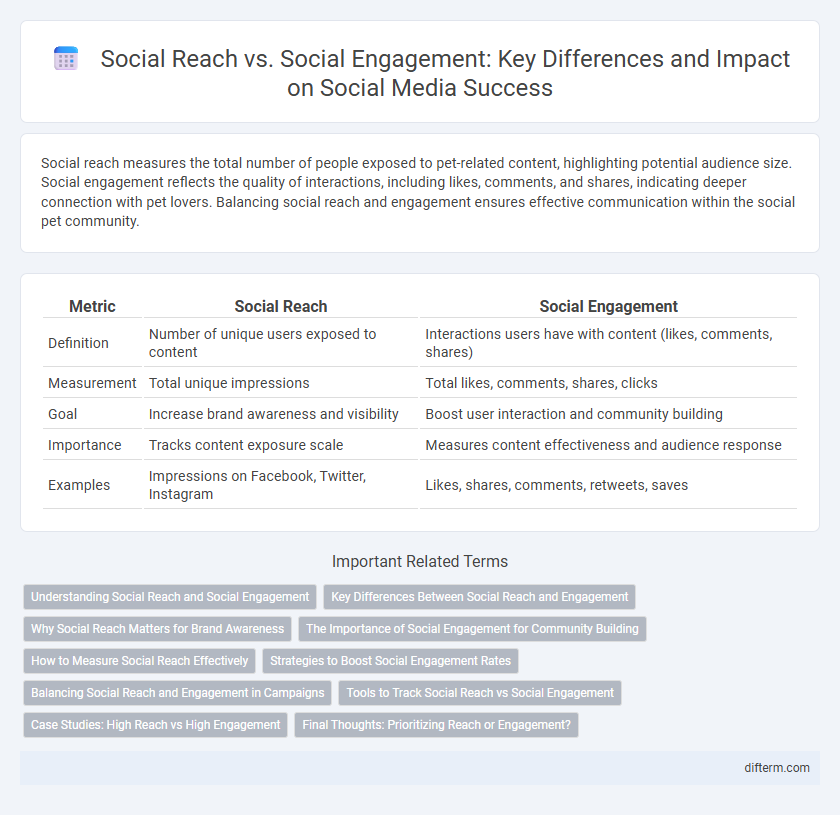Social reach measures the total number of people exposed to pet-related content, highlighting potential audience size. Social engagement reflects the quality of interactions, including likes, comments, and shares, indicating deeper connection with pet lovers. Balancing social reach and engagement ensures effective communication within the social pet community.
Table of Comparison
| Metric | Social Reach | Social Engagement |
|---|---|---|
| Definition | Number of unique users exposed to content | Interactions users have with content (likes, comments, shares) |
| Measurement | Total unique impressions | Total likes, comments, shares, clicks |
| Goal | Increase brand awareness and visibility | Boost user interaction and community building |
| Importance | Tracks content exposure scale | Measures content effectiveness and audience response |
| Examples | Impressions on Facebook, Twitter, Instagram | Likes, shares, comments, retweets, saves |
Understanding Social Reach and Social Engagement
Social reach quantifies the total number of unique users exposed to a piece of content, providing a broad measure of brand awareness and potential audience size. Social engagement refers to the interactions--such as likes, comments, shares, and clicks--that users perform, indicating the depth of connection and content relevance. Prioritizing both metrics enables marketers to balance widespread visibility with meaningful audience interaction, optimizing overall social media effectiveness.
Key Differences Between Social Reach and Engagement
Social reach measures the total number of unique users who see your content, reflecting its potential visibility across platforms like Facebook, Instagram, and Twitter. Social engagement captures the interactions--likes, comments, shares, and clicks--that users actively make with your content, indicating the level of audience involvement. The key differences lie in reach representing audience breadth, while engagement reflects depth and quality of user interaction.
Why Social Reach Matters for Brand Awareness
Social reach quantifies the total number of unique users exposed to a brand's content, making it a critical metric for expanding brand awareness across diverse audiences. Higher social reach increases the likelihood of content going viral, amplifying visibility and attracting potential customers. Brands leveraging broad social reach create more opportunities for engagement, fostering stronger connections and long-term loyalty.
The Importance of Social Engagement for Community Building
Social engagement drives deeper connections within communities by fostering meaningful interactions, which significantly enhance trust and loyalty among members. High social reach extends audience size but meaningful engagement transforms passive followers into active participants, fueling sustained community growth. Prioritizing dynamic conversations, personalized responses, and user-generated content boosts engagement metrics critical for vibrant, long-lasting social communities.
How to Measure Social Reach Effectively
Measuring social reach effectively requires analyzing the total number of unique users who have seen your content across platforms like Facebook, Instagram, and Twitter, using tools such as Google Analytics and native social media insights. Focus on metrics like impressions, follower growth, and shares to gauge the extent of content visibility. Combining reach data with engagement rates, including likes, comments, and click-throughs, offers a clearer picture of campaign impact and audience penetration.
Strategies to Boost Social Engagement Rates
Boost social engagement rates by creating interactive content such as polls, quizzes, and live videos that encourage active participation from your audience. Utilize personalized responses and timely interactions to foster a sense of community and build stronger connections with followers. Analyze engagement metrics regularly to refine content strategies and focus on high-performing posts that resonate with your target demographic.
Balancing Social Reach and Engagement in Campaigns
Balancing social reach and engagement in campaigns requires strategically targeting audiences that not only increase visibility but also foster meaningful interactions. Campaigns with high social reach amplify brand awareness across diverse demographics, while strong engagement builds loyalty and encourages shares, comments, and conversions. Optimizing content to resonate with niche segments ensures maximum impact by combining broad exposure with deep audience connection.
Tools to Track Social Reach vs Social Engagement
Tools like Sprout Social and Hootsuite provide comprehensive metrics for tracking social reach by measuring overall audience size, impressions, and share of voice across platforms. To analyze social engagement, platforms such as Buffer and AgoraPulse offer detailed insights into likes, comments, shares, and interaction rates to evaluate user activity and content effectiveness. Combining both reach and engagement tools enables marketers to optimize social strategies by aligning audience growth with active user participation.
Case Studies: High Reach vs High Engagement
Case studies reveal that campaigns with high social reach often generate broad awareness but may result in lower engagement rates per user, whereas high engagement campaigns foster deeper audience interaction and loyalty despite a narrower reach. Brands like Nike demonstrate that combining influencer collaborations with targeted content boosts both reach and engagement metrics. Analyzing metrics such as shares, comments, and time spent on posts provides critical insights for optimizing social media strategies to balance reach and engagement effectively.
Final Thoughts: Prioritizing Reach or Engagement?
Focusing on social engagement drives deeper connections and fosters brand loyalty, while prioritizing social reach enhances visibility and attracts a broader audience. Businesses aiming for long-term growth and community building should prioritize engagement metrics such as comments, shares, and interactions over mere follower count. Balancing reach with meaningful engagement ultimately leads to a more impactful and sustainable social media strategy.
social reach vs social engagement Infographic

 difterm.com
difterm.com